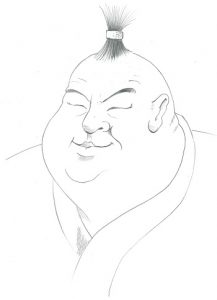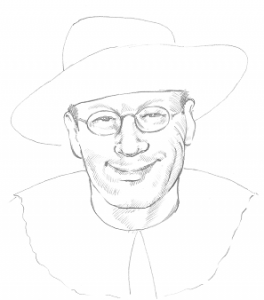Imaginary review by Dan Geddes
19 October 1999
One overlooked, undoubtedly tragic, consequence of the Cold War was the isolation of Eastern European artists and philosophers. Suppressed, imprisoned or even executed, some of these creative geniuses were prevented from publicizing works which did not toe the communist line. Sometimes Soviet leaders even executed artists who did not satisfy their demands. Stalin, for example, shot the portrait painter Bogdogovich for depicting the dictator with crude, yellowing teeth.
Since the end of the Cold War, however, Western researchers have been unearthing the works of many Eastern European artists, casting light on their rich, underground activity.
Towering over his oppressed contemporaries stands Maxim Maximovitch Sazonov, philosopher and poet, whose bleak vision of an absurd world may eventually earn him a posthumous reputation as one of the strongest poets in Russian history.
Sazonov: Early Life
Sazonov’s nihilistic vision of the world seems inevitable considering his impoverished upbringing. Born in 1930 in Leningrad, Sazonov lived his entire life behind the iron curtain. He was a sickly child: small, red-headed, with only one eyebrow—a single crescent of hair running across his forehead. He had few friends during his childhood, and spent most of his time alone in his room with piles of hollowed out apples, the purpose of which has given rise to wild critical speculation.[1]
Sazonov’s father, Maxim Mikhailovich, worked all his days in a rubber band factory in Leningrad, where he earned a pittance (even by Soviet standards), and was never promoted. Sazonov scholars have since uncovered a supervisor’s evaluation of Maxim Mikhailovich’s work ethic:
Maxim Mikhailovich is doubtless the laziest and stupidest human being I have ever encountered. Ever. Just yesterday I asked him to box some rubber bands as they came out of the machine. I went to check on him an hour later and found him snoring, sound asleep with a large mound of bands piling up all around him….
A few weeks ago Maxim was outwitted by “Stinking Lizaveta,” our charwoman, who swindled him out of his paycheck by repeatedly beating him at tick-tack-toe, claiming that going first was a disadvantage. Maxim would have been cheated again and again had I not warned him about the scam. To this day he insists he’ll beat her “next time.”
Sazonov’s mother, Anna, had an equally low opinion of her husband, writing in her diary:
I long for his death. I long for it. With all my heart. When will he die, Lord God? I weep and pray for a stray bolt of lightning, an industrial accident, an unfortunate fall out the window. Anything.”[2]
Thus, Maxim Maximovitch Sazonov grew up in miserable circumstances, son to a hapless father, and a probably insane mother whose repeated attempts to kill her husband—through poisoning, shooting, stabbing, hanging, lethal injection, a high cholesterol diet, dipping his cigarettes in kerosene, giving his name to the secret police, and beating him repeatedly with blunt objects—surely wrought damage on her young son’s developing psyche. His father, however, believed all these incidents were accidents, mere “tricks of Fate” as he called it, and never suspected his wife’s intentions.
Maxim Maximovitch, their only son, was soon sent off to school where he proved a very poor student. In kindergarten, for example, when asked to build a house out of toy blocks, he persistently used rubber balls, which would always collapse; young Sazonov never seemed to realize the inadequacy of his building materials. His elementary teachers write repeatedly of his “stupendous incompetence,” “goat-like mind,” and “reading comprehension of a rock.” He took an interest in athletics, however, playing goalie for the school hockey team; but his merciless teammates convinced him it was a special honor to play without a helmet, and young Maxim would inadvertently block shots with his head, perhaps precipitating a mild cerebral damage that would explain some of his later poetry.
As a youth he found little comfort at home. His beloved father served as a potato peeler for the Red Army from 1941-45, and he was left to the care of his violent mother, who, during the acute war-time shortages, fed him only boiled rubber bands and bland tomato sauce, dubbing the meal “pasta rings.”[3] His only childhood friend was the deranged Luttwak, who suffocated in a bowl of oatmeal at the Sazonov family’s breakfast table at the age of 16 .
The young ladies of Leningrad never took to Sazonov either, finding his sex appeal “on a par with cow dung,” in the words of one classmate. Maxim’s high school class voted him “most likely to marry a woman like his mother,” but young Sazonov wore the ribbon proudly, unaware of the jaded insult because of his intense fondness for his mother, who always called him “Frederico” for still mysterious reasons.
By 1948, the Cold War was in full swing, his father was back at the factory, and young Sazonov miraculously graduated from high school, due to what we now know was a typographical error. That Maxim Maximovitch Sazonov, age 18, semi-literate, the butt of his classmates, would become perhaps Russia’s greatest poet since Pushkin, is a tribute to the man’s unquenchable drive for self-improvement.
Having no marketable skills, Sazonov chose the path of many young Russians by joining the military. Sazonov chose the navy, and was soon stationed at the main Baltic fleet at Kronstadt. Here he was forced to shave his eyebrow, and endure rigorous physical training. But it was here, at the age of eighteen, on board the Soviet minesweeper Squeegee, that Sazonov started his now famous poetry journal. His first poem dates July 9, 1948, and reads:
How I hate my life!
My life is like vomited borscht.
Even the dogs pity me,
offering me their food
with sorrow in their eyes.
I hang from God, like a yo-yo
without a string;
no no, like a rubber band
that has snapped,
and lost all flavor.
All is pointless, pointless, pointless;
without a point.
I walk alone, I walk alone, I walk alone.
Alone I walk.
I walk alone.
This early, yet astonishing poetic fragment already displays many of the themes that would preoccupy Sazonov throughout his artistic life: a bitter hatred of life, the precariousness of life (as seen in the yo-yo and rubber band metaphors), a separation from God, and feelings of unquenchable loneliness. Although in English translation Sazonov’s expressions of loneliness may seem merely repetitious (“I walk alone, I walk alone, I walk alone”), in the original Russian (“ja edu soum, ja edu soum, ja edu soum”) they show the astonishing rhythmic skill that later would characterize his mature poetry.
Unfortunately Sazonov’s early naval career was not as auspicious as his poetry. His frustrated captain petitioned the Soviet High Command to create a new lowest rank (Asvaditchin), just for Sazonov. He also never learned to swim, and was confined to his quarters where his duties included counting the number of rivets in the ship’s hull. He emerged from below deck only a few times in his first tour of duty, often falling into the Baltic—perhaps not accidentally.[4] But this isolation gave Sazonov the time he needed to create his first major poetic masterpiece, October, 1950, which surely will earn him a place among the world’s great poets.
Early Works
On the surface, October, 1950, appears to be a mere collection of journal entries—a recording of the rather boring details of a young, somewhat stupid, Russian sailor’s life. Indeed, the first literary scholar to examine Sazonov’s papers, Edmund Ain of Cambridge, concluded that October, 1950
…is the mere ranting of a lunatic. I would bury it under a large rock for a thousand years were it not for its historical value, the light it sheds on the disturbing effects of communism on young Russians during the early Cold War.[5]
Ain, however, soon passed Sazonov’s papers on to the renown literary critic Francois Boulanger, who immediately realized their priceless literary value, and who can be said to have “discovered” Sazonov. Indeed, my own interpretation of Sazonov’s work closely follows Boulanger.
Consider the first stanza:
October 1st, 1950
I am given only
stale bread to eat.
My parents have moved,
and left no new address.
Smerdyakov beats me senseless every day,
and every day I pray,
I pray,
that America will nuke us.
Already, Sazonov’s expression of existential ennui achieves staggering power. Bread, the very symbol of life, is stale for Sazonov; and later in the poem we find that “stale” is Sazonov’s evaluation of all of western civilization as well (“our ship sails west/ and still the bread is stale”).
When the poet says his parents have moved, he surely intends it as a metaphor for his alienation from traditional Russian values, because as is well known, his parents did not move, but simply refused to answer his increasingly lonely and hysterical letters.
The mention of “Smerdyakov” in line five has puzzled many scholars, because the Squeegee’s logs show that no one of that name ever served on board that ship, or indeed in the Soviet navy at all. “Smerdyakov,” however, is the name of the fourth son in Dostoevsky’s The Brothers Karamazov. Indeed, since in the novel Smerdyakov is the son who killed Fyodor Karamazov, we see how Sazonov imagines himself a daily victim of horrible crimes (“Smerdyakov beats me senseless every day”).[6]
The desperate repetition of Sazonov’s “I pray/ I pray”, so similar to his other characteristic repetitions, shows Sazonov’s belief in the futility of prayer. The fact that he prays for a nuclear holocaust is one of the most memorable expressions of a Freudian death wish in modern literature. Boulanger sees Sazonov’s lines as a deliberate echo of T.S. Eliot’s famous, albeit less subtle, death wish lines:
I want to die,
Kill me, Kill me,
I wish to die.
I must have a Freudian death wish.[7]
The second stanza continues Sazonov’s expressions of nihilistic, pre-post-modern anomie:
October 2nd, 1950
Last night
I poked my head
out of my porthole
and duckshit hit me
in the neck.
I was mad about it,
but soon got over it.
Here we see Sazonov’s persona’s efforts to escape the grueling regimen of military life. A simple desire for a breath of fresh air results in a punitive raid of duck excrement, symbolic of an unfeeling cosmos. There has been much critical debate over why Sazonov chose the line “in the neck”. On the surface, it seems like a logical place for the feces to land, considering the situation. But the Russian phrase (“u sheu”) is ambiguous, possibly meaning “in the neck”, but also meaning “on my collar” or “some yogurt would be nice.” In any event, Sazonov shows his characteristic resiliency. At first he is mad (“I was mad about it”) at a world that would soil him merely for sticking his head out a porthole, but the fact that he soon gets over it (“but soon got over it”) shows his forgiveness toward a hostile world, despite all the humiliation he has endured in his young life.
October, 1950 continues for twenty-nine more stanzas, thirty-one in all, and is too lengthy to receive full critical treatment here.[8]
Later Life and Works of Maxim Maximovitch Sazonov
A pivotal event in Sazonov’s life occurred in the summer of 1953. On leave in Moscow, he decided to pay his respects by attending Stalin’s funeral, dead after nearly thirty years of ruthless tyranny. During the massive state funeral, Sazonov ran into an old classmate of his, Voronsky, who told Sazonov that it was an old Russian custom to shout “Down with Stalin!” (or whomever) as a ruler’s body is lowered into the ground.[9] With clenched fist and tears in his eyes, Sazonov solemnly complied, and was immediately arrested by the NKVD.
At his trial two years later, Sazonov’s crime earned him a life prison sentence, as well as an additional forty-five years for contempt of court, for his “audacity” in claiming that he only intended to wish the dictator a peaceful transition to the afterlife. Voronsky, in attendance, laughed hysterically for the length of the trial, stopping only to pare his fingernails.
Thus, Sazonov was unjustly sentenced to exile in the Siberian industrial city of Irkutsk. Here he is said to have met the famous dissident writer Alexander Solzhenitsyn, spilling soup on him. It was also here that Sazonov met the love of his life, Katherina Ivanova.
Katherina, a beautiful poetess, had been sentenced to life-in-exile back in 1949 for writing the lines “…Marx looked like a cat/ and bathed less…”, in her never-produced blank-verse drama Man of Stench, which treated Marx’s London years. To her dying day, Katherina defended Man of Stench as an “historical epic,” told only from the point of view of a “Trotskyite mouth-piece,” a character whose political beliefs never reflected her own.
Maxim and Katherina soon fell in love, and remained married for the duration of their lives. Sazonov describes their historic first meeting in his Journals:
During one of my very first days in Irkutsk, I was trying to chop wood, when a beautiful woman approached me, her blonde hair cascading down over her white ski-suit. Immediately, I dropped the ax on my foot. I said: “Ow! That really hurt!” and she nodded compassionately in agreement. We have been constant companions ever since.
Katherina recorded the incident somewhat differently:
Before I came to Irkutsk I had been subject to many psychological experiments at the secret KGB laboratory in Minsk. One of the political psychologists was trying to prove that women, if pumped full of drugs and subjected to weeks of sleeplessness and hypnotic suggestion, could find even the most repulsive man wildly attractive. Then they sent me to Sazonov.[10]
I have to admit that under the circumstances I fell in love….Only now, near the end of my life, do I understand I was just a guinea pig for the Soviet scientists, but what can I say about the man I’ve spent most of my life with? Well…I guess I can say he’s the most pathetic hamster I’ve ever encountered.
Despite this entry from Katherina’s journals, most other evidence suggests they were a happy couple. Certainly Sazonov found inspiration from his new wife, and this is reflected in his later works, which display a newfound optimism.
Sazonov’s next masterpiece, October, 1962, written at the height of the Cuban missile crisis, shows his bravery in the face of potential nuclear annihilation:
What if they nuke us?
I guess I would die.
And Katherina too.
Oh God, Oh God,
I don’t want to die
When Katherina acts so odd.
Here Sazonov shows a life-affirming attitude in the face of nuclear annihilation. He admits the reality of his potential death (“I guess I would die”) but shows a newfound concern for others (“And Katherina too”). He also expresses a growing religious yearning (“Oh God, Oh God”) which is lacking in his early poetry. By “Katherina acts so odd” Sazonov must be referring to his wife’s construction of a guillotine, ostensibly for a never-produced political play she attempted to stage in Siberia.[11] But the couple remained happy, as evidenced by numerous photographs showing Katherina’s beaming smile.[12]
Sazonov and Katherina remained in exile until 1985, when the new Secretary General Mikhail Gorbachev released many political prisoners. They soon moved to Moscow, where Katherina took a job in a pharmacy, and Sazonov remained unemployed, despite his desire to work with produce. Oddly enough, he seems to have made no effort to publish his poetry. In his later years Sazonov was the victim of paranoid fears that he was really a moose, and avoided social interaction.
In the fall of 1989, at the age of 59, Sazonov noted the revolutionary changes occurring in Eastern Europe and so traveled to Berlin to participate. He was even on hand for the collapse of the Berlin Wall, and managed to secure a fragment for himself as a souvenir. But an elderly woman nearby was jealous, and asked him if he would like to trade it for a “moonrock.” Sazonov reportedly said “yes, of course” but she bashed him over the head with it anyway. The woman was taken into custody, the police report noting that the “moonrock” bore “an uncanny resemblance to a brick.” Unfortunately for the world of literature, Sazonov never recovered from the blow. He staggered around Berlin for a few hours scribbling “Apples and rubber; that is life’s meaning,” and died a few paces west of the newly-demolished Berlin Wall.
Katherina, on the hearing the news of her husband’s death, cried “Yes!” and went on a sex spree, wild enough, in the words of one observer, “to make a porno star blush.” Though nearing sixty herself, Katherina had retained her figure, and was rumored to have satisfied the entire Moscow 6th battalion.
Sazonov’s Legacy
Although critics are still poring over Sazonov’s massive notebooks, his place in literary history is assured. His work displays a thoroughly modern temperament, as seen in his engagement of existentialist issues and use of free verse. Most importantly, his inventive use of journals-as-poetry says more about the nature of time—a perennial poetic issue—than countless books on the subject. Regardless of the verdict on the rest of his poetry, October, 1950 and October, 1962 ensure Sazonov a place among the greatest of Russian poets.
We can only hope, as scholars unearth more works of Eastern bloc artists, that more Sazonovs will be discovered.
[1] Some critics, notably the leading Sazonov critic Francois Boulanger, have seen Sazonov’s youthful, rotten apples as symbolic cries of the child’s Edenic fall from innocence. Others have seen them as early Sazonovian attempts at sculpture, an art for which he clearly was not destined. For a more mundane view of the apples see Frank Phlaeton’s Sazonov: The Horticultural Poet. For a less likely interpretation see George Ranke’s Sazonov: Philosopher, Pervert, Poet.
[2] In light of these longings, it is something of a mystery why Anna married him at all. The most convincing explanation to date is Anna’s excessive appetite, which kept many other suitors away. Reputedly she could devour an entire lamb and gallon of coleslaw during a single marathon sitting, washing it down with a quart of potent vodka. Unfortunately her prayers for his death were not answered, as Maximim Mikhailovich outlived her, dying in 1983, some fifteen years after her death.
[3] This helps explain Sazonov’s strange practice, which he maintained until late in life, of inexplicably gnawing on erasers.
[4] A former shipmate of Sazonov has reported that many of the sailors pushed the young poet into the sea, throwing cement-filled life preservers at him while he frantically struggled to stay afloat. Luckily he was always caught in the minesweeper’s nets and brought on deck.
[5] Ain believes it is sheer folly to consider Sazonov’s Journal to be a series of poems at all! For Ain they are merely “journal entries,” elevated to the status of high poetry sheerly through “overweening critical interpretation” of critics such as Boulanger. He even contends that the most plausible explanation for Sazonov’s now famous “clipped lines”—what Boulanger has called “the most inventive use of free verse to date”—is Sazonov’s practice of writing on a very narrow pocket pad.
[6] A less likely interpretation comes from Edmund Ain. Ain’s original interpretation of the Smerdyakov character is simply that one of Sazonov’s shipmates, Smerdyakovcosmonautskivitch, who did indeed beat Sazonov often, was simply called “Smerdyakov” for short by his shipmates.
[7] These lines were cut from the “The Wasteland” on the advice of Eliot’s editor, Ezra Pound, who found them “liberatingly cheerful when compared to the general tone of your poem.” Pound himself, however, later stole them, putting them into his last Cantos after first translating them into Classical Sanskrit.
[8] Those seeking a full critical analysis of October, 1950 should consult Francois Boulanger, Sazonov: Poet and Prophet. Skeptical critics should keep in mind Edmund Ain’s staggering suggestion that October, 1950‘s thirty-one stanzas are literally thirty-one journal entries, one for each day of the month.
[9]Stalin of course was not even to be buried at all, but entombed next to Lenin in the Kremlin.
[10] This research was later used to help secure mistresses for Secretary General Leonid Brezhnev.
[11] Edmund Ain has proposed the theory that Katherina’s guillotine was really intended for Sazonov! See Ain, op cit., pp. 56-67.
[12] Edmund Ain, however, believes that Katherina’s “happiness” is attributable to her daily druguse (“enough to fell a rugby team”).











Be First to Comment